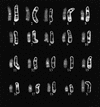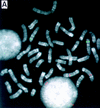Mouse molecular cytogenetic resource: 157 BACs link the chromosomal and genetic maps
- PMID: 10330132
- PMCID: PMC310771
Mouse molecular cytogenetic resource: 157 BACs link the chromosomal and genetic maps
Abstract
We have established a collection of strong molecular cytogenetic markers that span the mouse autosomes and X chromosome at an average spacing of one per 19 Mb and identify 127 distinct band landmarks. In addition, this Mouse Molecular Cytogenetic Resource relates the ends of the genetic maps to their chromosomal locations. The resource consists of 157 bacterial artificial chromosome (BAC) clones, each of which identifies specific mouse chromosome bands or band borders, and 42 of which are linked to genetic markers that define the centromeric and telomeric ends of the Whitehead/MIT recombinational maps. In addition, 108 randomly selected and 6 STS-linked BACs have been assigned to single chromosome bands. We have also developed a high-resolution fluorescent reverse-banding technique for mouse chromosomes that allows simultaneous localization of probes by fluorescence in situ hybridization (FISH) with respect to the cytogenetic landmarks. This approach integrates studies of the entire mouse genome. Moreover, these reagents will simplify gene mapping and analyses of genomic fragments in fetal and adult mouse models. As shown with the MMU16 telomeric marker for the trisomy 16 mouse model of Down syndrome, these clones can obviate the need for metaphase analyses. The potential contribution of this resource and associated methods extends well beyond mapping and includes clues to understanding mouse chromosomes and their rearrangements in cancers and evolution. Finally it will facilitate the development of an integrated view of the mouse genome by providing anchor points from the genetic to the cytogenetic and functional maps of the mouse as we attempt to understand mutations, their biological consequences, and gene function.
Figures






Similar articles
-
Integration of cytogenetic with recombinational and physical maps of mouse chromosome 16.Genomics. 1999 Jul 1;59(1):1-5. doi: 10.1006/geno.1999.5812. Genomics. 1999. PMID: 10395793
-
Integration of genetic, physical, and cytogenetic maps for Brassica rapa chromosome A7.Cytogenet Genome Res. 2010 Jul;129(1-3):190-8. doi: 10.1159/000314640. Epub 2010 Jul 13. Cytogenet Genome Res. 2010. PMID: 20628251
-
Development of pachytene FISH maps for six maize chromosomes and their integration with other maize maps for insights into genome structure variation.Chromosome Res. 2012 May;20(4):363-80. doi: 10.1007/s10577-012-9281-4. Epub 2012 May 16. Chromosome Res. 2012. PMID: 22588802 Free PMC article.
-
"KARIBIN," an information resource for obtaining genomic information in a cytogenetic band.Genome Res. 1999 Jan;9(1):91-8. Genome Res. 1999. PMID: 9927488 Free PMC article. Review.
-
[Extending the capabilities of human chromosome analysis: from high-resolution banding to chromatin fiber-FISH].Hum Cell. 1997 Jun;10(2):121-34. Hum Cell. 1997. PMID: 9390269 Review. Japanese.
Cited by
-
Deciphering the Contributions of CRH Receptors in the Brain and Pituitary to Stress-Induced Inhibition of the Reproductive Axis.Front Mol Neurosci. 2018 Aug 30;11:305. doi: 10.3389/fnmol.2018.00305. eCollection 2018. Front Mol Neurosci. 2018. PMID: 30214395 Free PMC article.
-
Cohesin SMC1beta protects telomeres in meiocytes.J Cell Biol. 2009 Oct 19;187(2):185-99. doi: 10.1083/jcb.200808016. J Cell Biol. 2009. PMID: 19841137 Free PMC article.
-
PDGF autocrine stimulation dedifferentiates cultured astrocytes and induces oligodendrogliomas and oligoastrocytomas from neural progenitors and astrocytes in vivo.Genes Dev. 2001 Aug 1;15(15):1913-25. doi: 10.1101/gad.903001. Genes Dev. 2001. PMID: 11485986 Free PMC article.
-
Alternative lengthening of telomeres in normal mammalian somatic cells.Genes Dev. 2013 Jan 1;27(1):18-23. doi: 10.1101/gad.205062.112. Genes Dev. 2013. PMID: 23307865 Free PMC article.
-
A comprehensive BAC resource.Nucleic Acids Res. 2001 Jan 1;29(1):141-3. doi: 10.1093/nar/29.1.141. Nucleic Acids Res. 2001. PMID: 11125072 Free PMC article.
References
-
- Boyle AL, Feltquite DM, Dracopoli NC, Housman DE, Ward DC. Rapid physical mapping of cloned DNA on banded mouse chromosome by fluorescence in situ hybridization. Genomics. 1992;12:106–115. - PubMed
-
- Breneman JW, Ramsey MJ, Lee DA, Eveleth GG, Minkler JL, Tucker JD. The development of chromosome-specific composite DNA probes for the mouse and their application to chromosome painting. Chromosoma. 1993;102:591–598. - PubMed
-
- DeBry RW, Seldin MF. Human/mouse homology relationships. Genomics. 1996;33:337–351. - PubMed
-
- Dietrich WF, Miller J, Steen R, Merchant M, Damron-Boles D, Husain Z, Dredge R, Daly MJ, Ingalls K, O’Connor TJ, et al. A comprehensive genetic map of the mouse genome. Nature. 1996;380:149–154. - PubMed
Publication types
MeSH terms
Substances
Grants and funding
LinkOut - more resources
Full Text Sources
Molecular Biology Databases
Research Materials
Miscellaneous
